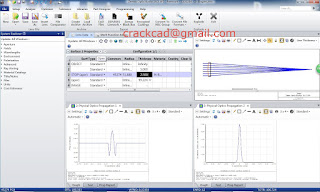Zemax.OpticStudio.V16.5.SP5.download.tutorials
OpticStudio 16.5 Service Pack 5 contains the following fixes and enhancements. Sequential surfaces and ray tracing •
Mechanical Semi-Diameters – The calculation of mechanical semi-diameters on surfaces in some systems that contain coordinate breaks has been corrected. • Ray Aiming – The ray aiming algorithm has been improved for modeling systems in which the stop surface is significantly off-axis.
• Q-Type Asphere – The algorithm for ray tracing a Q-Type Asphere has been improved for surfaces that have a steep curvature. •
Add Fold Mirror – An issue has been resolved with the Add Fold Mirror tool for systems that contain a Q-Type Asphere and multiple configurations.
• Mirror Substrate – An issue has been resolved regarding how OpticStudio models the back side of a mirror that has a mechanical semi-diameter that is larger than its clear semi-diameter Sequential analyses and calculations
• Through Focus FFT MTF – Improvements have been made to the performance of the Through Focus FFT MTF calculation; the calculation time has been reduced by up to a factor of two in some cases.
• Convert File Format – An option to enable or disable fitting of input data to a Gaussian beam has been added to the Convert File Format tool, which converts Optiwave F3D files to OpticStudio ZBF files. Fitting the data to a Gaussian beam is enabled by default.
• Beam File Viewer – An option has been added to the Beam File Viewer so users can change the projection that is used to display ZBF data. This option mimics the option in the Physical Optics Propagation (POP) analysis.
• Beam File Viewer – The rendering speed has been improved for the Beam File Viewer in sequential mode. Non-sequential objects and ray tracing
• Faceted Surface objects – An issue has been resolved with the Faceted Surface object in non-sequential mode; the X Half Width is now correctly limited when the shape of the surface is toroidal.
• Source Diode – Improvements have been made to the Source Diode object in non-sequential mode; a larger range of angles can now be used for the source distribution in a Gaussian model • Boolean objects – The algorithm that is used to create a Boolean object in non-sequential mode has been improved when one of the parent objects is a Biconic Zernike lens.
• Object Editor – Improvements have been made to the user interface for the NSC Object Editor to improve readability of text in the Explorer tree. Programming • ZOS-API – The IAS_PathAnalysis interface is now exposed for COM connections (such as COM connections from C++ or
 Software training,tutorials,download,torrent
Software training,tutorials,download,torrent